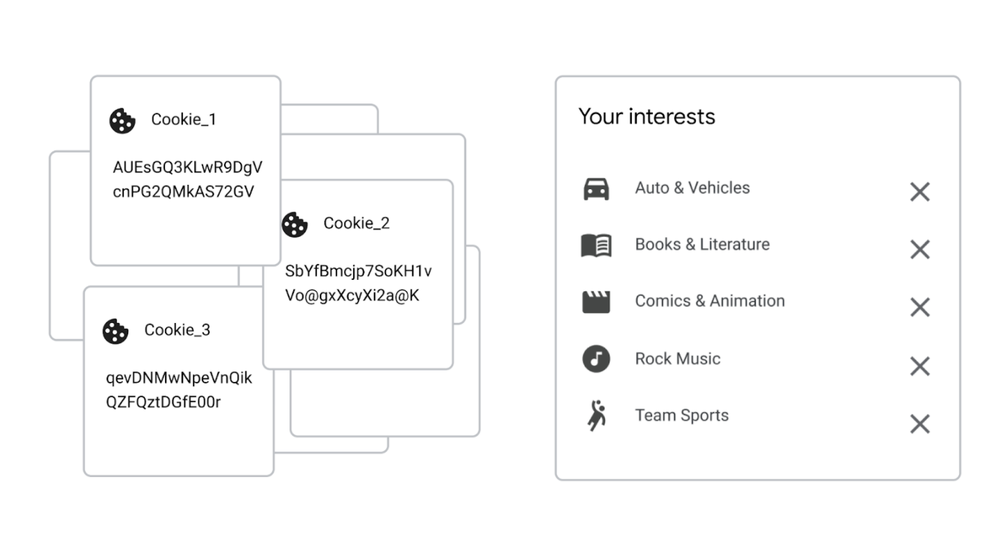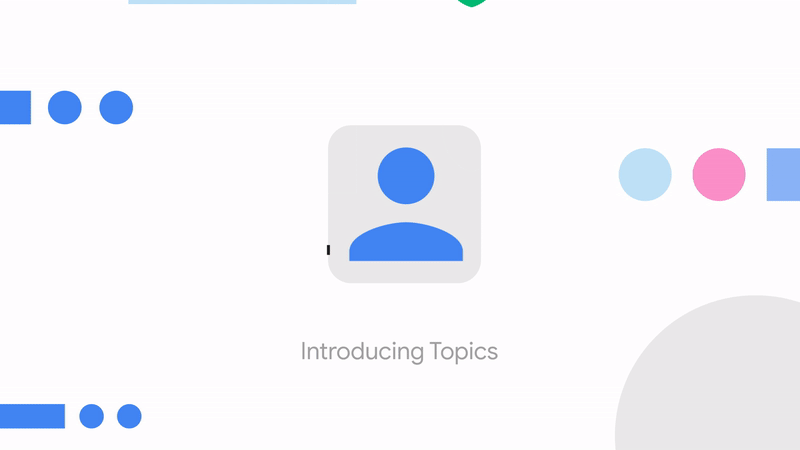In order for that shift to happen, they built out a “Privacy Sandbox”, highlighting all the proposed APIs and tools to get them there. In our 2021 blog, “Google Privacy Sandbox Explained”, we dedicated a section to Google’s proposed Federated Learning of Cohorts (FLoC) API, which would have been used to identify online users.
In January 2022, Google announced they would be replacing the Federated Learning of Cohorts API with Topics. Why? We’ll dive into the following topics:
Why is Google Replacing FLoC
The original FLoC API would generate an alphanumerical-stringed ID, which would reflect a user’s browsing pattern on Chrome.
For example, Criteo discovered that you could still monitor and cross-track users’ browsing habits and cohort assignments using FLoC IDs. Also, FLoC didn’t address the issues related to sensitive category targeting or fingerprinting either.
Comparing that to third-party cookies – it didn’t seem to protect user privacies better. After extensive testing in the summer of 2021 and receiving feedback, Google decided to scrap the FLoC plan and go back to the drawing board.
The end goal is to appease advertisers and consumers (internet users) alike. Google wants to strike a balance between making interest-based advertising available to brands while having more robust protection for user privacy.
How Does the Topics API Work?


Topics will allow Chrome to choose up to a maximum of five topics that represent a user’s top interest for a certain time period (three weeks), based on the websites they visited. Examples of Topics could be travel, music genre, books, team sports, etc.
Websites would opt-in to participate in Topics API to serve personalized ads. When a user visits a site, the API will select three topics (one from each of the past three weeks) and share them with the site and its advertising partners.
The three topics unique to the user will be available for the next three weeks. Afterward, they will be replaced by new topics.
Google plans to start with 350 topics to categorize user interest and activity. They will expand the set of topics as they continue to test and receive feedback. AdExchanger reports that Google may be seeking a third-party like IAB Tech Lab to maintain the taxonomy.
Improving on the shortcomings of FLoC, the new Topics API will address the sensitive category targeting issue by pulling topics curated by humans (instead of machines) and manually exclude sensitive categories like race, religion, or sexual orientation.
Also, to bypass the fingerprinting issue, Google will limit the number of topics shared of each user. Chrome users will have the option to disable the Topics feature completely, or see what topics are being shared about them.
Three topics per user every few weeks sounds limited, but Google is trying to counterbalance that by offering combined topics, for example, a book lover who also loves hip hop, to enable a deeper level of audience targeting.
Google’s Topics API will utilize machine learning via user devices. Take a look at this step-by-step breakdown:

Topics is Interest-Based Advertising
Google’s Topics API was proposed to be an elevated version of FLoC with improved user privacy protection.
Advertising is often contextual-based, which means an ad is more relevant to the content that it’s served around. It’s helpful because users who actively sought out that content are more likely to be interested in your ad. Google Topics API will move away from contextual advertising and instead be interest-based.
What is Interest-Based Advertising?
A form of personalized advertising that chooses the ad content for a user based on their interests drawn from the websites they have visited.
What is Interest-Based Advertising?
- It helps advertisers reach potential customers
- Fund websites that can’t easily monetize site visits solely through contextual advertising
- Supplements contextual information for the current webpage to help find an appropriate ad for the visiting user
Pros & Cons of Topics API
- The Topics API will notify you if a topic you get for a user is one of their top 5 topics of the week
- Websites with ongoing relationships with users will get more data (first-party data is king)
- There is transparency and individual control for both users and websites. You can see the topics assigned to you, remove the ones you don’t like, or even opt out
- The API protects users and reduces fingerprinting
- All Topics will be public and human-curated to avoid sensitive topics like religion and race
On the other hand, here are some of the shortcomings from an advertiser’s perspective:
- Users could opt-out from being tracked
- Less user data for targeting
- Data expires every three weeks
- Limits measurement
- Harder to cross-correlate / fingerprint users
In Google’s technical explainer, they highlight these items as the step towards their privacy goals. It “provides a more private alternative than tracking to help deliver relevant ads.”
Note that Topics is currently still in its proposal stage. Google is going to keep an open conversation with the public. It would help them test and decide what the final form of Topics API would look like.
What Should Brand Advertisers Do with Topics API?
There’s no doubt that the move away from third-party cookies is a step-down when it comes to advertising.
It will limit ways to granularly target people with personalized ads, which may likely affect reach and frequency.
– Ben Galbraith, Google Chrome Product Lead
Advertisers had expressed concern with the limit of five topics a week for each user. You probably daydream about where to vacation next, look up what movies to watch, what restaurant to eat at, how to get there, look for information to troubleshoot an issue at work, and maybe check out the online sale of your favorite brand. That’s already six topics!
As advertisers, we must adapt to the shift from contextual-based advertising to interest-based. With these new limitations, ad tech and publisher companies will again have to work together to overcome the challenges of ad targeting and measurements. Sure, it might take a bit of work and time, but remember Apple’s iOS 14 update? People panic at the initial change, but things settle back down once we build out new tech solutions. It’s the new normal!
Ultimately, users can enjoy more anonymity when browsing the internet, which is where the future of technology is headed.
- Focus on building first-party data. You won’t need to worry about algorithm updates or limitations to targeting, if you build stronger relationships with your customer base. Your audience data would be rock solid.
- Try out new advertising channels, such as Over-The-Top ads. Stats in the US show that 92% of households already have ad-supported Connected TV devices. Think of other touchpoints in the customer journey you can cover!
- Go programmatic. Sophisticated programmatic advertising harnesses the power of data, accesses a wide range of publishers, and effectively serves ad campaigns across channels. 39% of marketers plan to increase their programmatic ad spend in the next 12 months.
- If you’re running digital ad campaigns in-house on your own and find that your ad performance is negatively impacted whenever there are new changes, consider partnering with an ad agency like War Room.
- Demand Side Platform
- Cross-Channel Center
- Campaign Manager
- Audience Center
- Inventory Searching & Buying
- Verification
- Data Insights Center and more
We stay on top of and navigate confidently through these algorithm updates, so our clients don’t have to stress. After all, our mission is to take the fear out of digital advertising.
You can learn more about our services here, or check out our Advertising Institute for other digital resources like this blog!
Additional Readings
Let's Work Together
Say hello to customized advertising strategies that convert.
Get in touch with our programmatic experts today!











